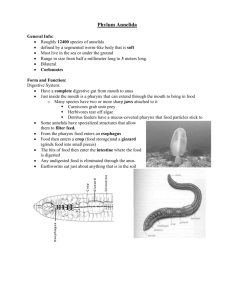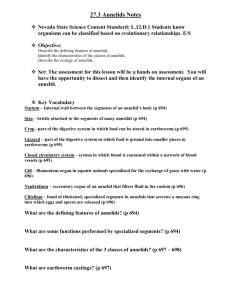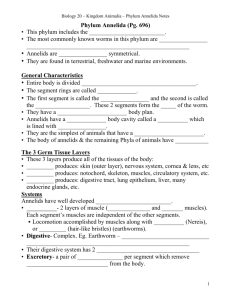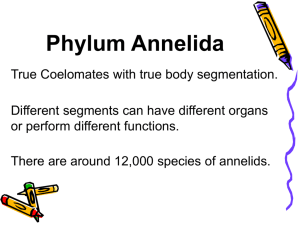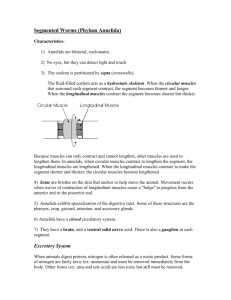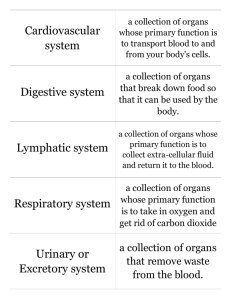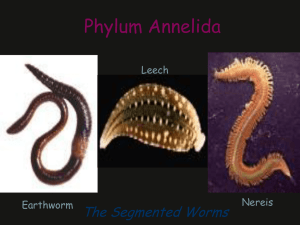27-2 Phylum Annelida
advertisement
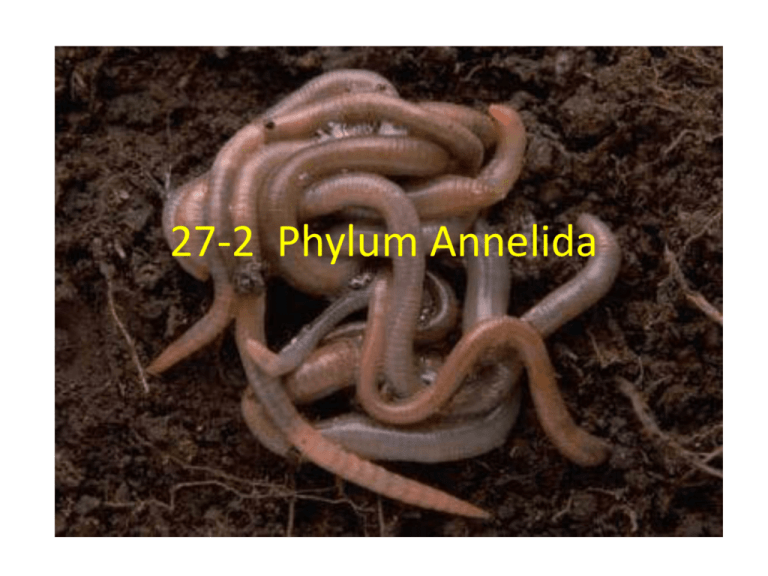
27-2 Phylum Annelida I. What is an Annelid? A. Phylum: Annelida from Latin annellus = little rings B. Description: Round, wormlike animal that has a long, segmented body C. Size: <1/2 mm to >3 m The Coelom • Let’s start at the beginning…. As animals become more complex the develop different tissue layers. Sponges are multicellular but don’t really have a tissue layer But as things get more complex: three tissue types develop: 1. 2. 3. Ectoderm: outer embryonic layer - skin and nervous tissue Endoderm : lines digestive tract Mesoderm: muscles, bones, circulatory system, organs In Cnidarians you see aggregations of tissue into layers. ectoderm and endoderm separated by a noncellular mesoglea ( translucent, inert, jelly-like substance that It acts as the creatures' structural support) Body Cavities: Coeloms So flatworms have: – three layers of tissue – no body cavity – body double-walled sac surrounding digestive cavity – single opening to outside • Roundworms: body cavity between mesoderm and endoderm, but not a real coelom: a pseudocoelom • Annelids: – tube within a tube = body cavity Advantages – body cavity allows more room for organs in fluid filled cavity with no pressure from muscles – cavity can serve as circulatory system – more efficient and longer digestive system – more room for gonads, gametes, etc. – can function as a hydrostatic skeleton. II. Form and Function in Annelids A. Septum: Internal walls 1. Most of the body segments are identical to one another but some segments are modified to perform special functions For example the first few segments may carry one or more pairs of eyes, antennae, or other sense organs B. Feeding 1. Describe how Annelids feed: Food enters through the mouth and travels through the gut and digested 2. Pharynx: Muscular front end of the digestive tube a) Why is the pharynx different in different types of annelids? To suit the different types of food they eat C. Respiration 1. Describe how different annelids breathe when they live in various habitats a) Aquatic: Gills b) Terrestrial: Through their skin 2.Why do worms have to live in moist areas? Gas exchange occurs through the skin D. Internal Transport In Annelids Closed circulatory system: System in which blood moves inside blood vessels. In Earthworms there are longitudinal vessels running the entire length of the worm, one dorsal and several ventral. Connecting the dorsal and ventral vessels, and so completing the circuit are five pairs of hearts, E. Excretion 1. Produces 2 kinds of wastes: a) Solid wastes: Pass out through the anus at the end of the gut b) Cellular metabolic wastes: nephridia 2. Nephridia: Simple tube-shaped excretory organ used to remove ammonia from the blood and release it from the body F. Response Brain is on top of the gut at the front end of the body. Two large nerves pass around the gut and connect the brain with a pair of ganglia below. From these ganglia, a ventral nerve cord runs the entire length of the worm. Nerves from each segment of the worm enter and leave the nerve cord at a pair of small ganglia. These nerves help carry messages from sense organs and coordinate the movement of muscles. 2. Sense organs: a) Best developed in the free-living marine species (polychaetes) • palps, antennae, eyes, statocysts, nuchal organs and lateral organs b) Earthworms have no specialized sense organs 3. Defense from predators (earthworm): a) Grab onto the wall of their burrow G. Movement 1. Two major groups of muscles in their body walls: a) Longitudinal b) Circular 2. Longitudinal muscles contract, they make the worm shorter 3. Circular muscles make the worm skinnier H. Reproduction 1. Most annelids reproduce sexually 2. Some species have separate sexes and external fertilization with females and males releasing gametes into the open water where fertilization occurs 3. Some species are hermaphrodites with internal fertilization 4. Clitellum: Secretes a mucus ring into which eggs and sperm are released IV. Earthworms and Their Relatives A. B. 1. 2. Class: Oligochaeta Earthworm Description: Long pink worms Habitat: Soil C. How are oligochaetes different than their relatives, the marine polychaetes? Have fewer bristles V. Leeches A. Class: Hirudinea B. Habitat: Freshwater, ocean, terrestrial C. Describe how leeches feed: Leeches penetrate the skin then use their muscular pharynx to suck blood from the area VI. How Annelids Fit into the World 2 examples of annelids and their role in the ecosystem: 1. Are food for other organisms 2. Condition the soil (aerate, speed up the return of nitrogen)
